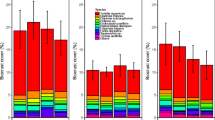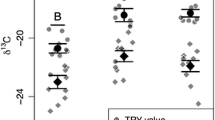Abstract
Regular additions of NH4NO3 (35–140 kg N ha−1 yr−1) and (NH4)2SO4 (140 kg N ha−1 yr−1) to a calcareous grassland in northern England over a period of 12 years have resulted in a decline in the frequency of the indigenous bryophyte species and the establishment of non-indigenous calcifuge species, with implications for the structure and composition of this calcareous bryophyte community. The lowest NH4NO3 additions of 35 kg N ha−1 yr−1 produced significant declines in frequency of Hypnum cupressiforme, Campylium chrysophyllum, and Calliergon cuspidatum. Significant reductions in frequency at higher NH4NO3 application rates were recorded for Pseudoscleropodium purum, Ctenidum molluscum, and Dicranum scoparium. The highest NH4NO3 and (NH4)2SO4 additions provided conditions conducive for the establishment of two typical calcifuges – Polytrichum spp. and Campylopus introflexus, respectively. Substrate-surface pH measurements showed a dose-related reduction in pH with increasing NH4NO3 deposition rates of 1.6 pH units between the control and highest deposition rate, and a further significant fall in pH, of >1 pH unit, between the NH4NO3 and (NH4)2SO4 treatments. These results suggest that indigenous bryophyte composition may be at risk from nitrogen deposition rates of 35 kg N ha−1 yr−1 or less. These effects are of particular concern for rare or endangered species of low frequency.


Similar content being viewed by others
References
Bobbink, R., Ashmore, M., Braun, S., Flückiger, W., & Van den Wyngaert, I. J. J. (2002). Empirical nitrogen critical loads for natural and semi-natural ecosystems: 2002 update. In Empirical critical loads for nitrogen-expert workshop, (pp 43–170) Berne, 11–13 November 2002, Swiss Agency for the Environment, Forests and Landscape (SAEFL).
Bobbink, R., Hornung, M., & Roelofs, J. G. M. (1998). The effects of air-borne nitrogen pollutants on species diversity in natural and semi-natural European vegetation. Journal of Ecology, 86, 717–738.
Burch, J. A. (2001). The Response of bryophytes to elevated atmospheric deposition of nitrogen, PhD Thesis (273). Department of Animal and Plant Sciences, University of Sheffield.
Carroll, J. A., Caporn, S. J. M., Johnson, D., Morecroft, M. D., & Lee, J. A. (2003). The interactions between plant growth, vegetation structure and soil processes in semi-natural acidic and calcareous grasslands receiving long-term inputs of simulated pollutant nitrogen deposition. Environmental Pollution, 121, 363–376.
Carroll, J. A., Johnson, D., Morecroft, M., Taylor, A., Caporn, S. J. M., & Lee, J. A. (2000). The effect of long-term nitrogen additions on the bryophyte cover of upland acidic grasslands. Journal of Bryology, 22, 83–89.
Cunha, A., Power, S. A., Ashmore, M. R., Green, P. R. S., Haworth, B. J., & Bobbink, R. (2002). Whole ecosystem nitrogen manipulation – an updated review, report no. 331. Peterborough, UK: Joint Nature Conservation Committee.
Hewins, E. J., & Ling, K. A. (1998). The impacts of management and atmospheric ammonia deposition on plant communities of calcareous grasslands, Book of Abstracts. Rothamsted: CAPER.
Jäppinen, J. P., & Hotanen, J. P. (1990). Effect of fertilization on the abundance of bryophytes in two drained peatland forests in Eastern Finland. Annales Botanici Fennici, 27, 93–108.
Koerselman, W., & Meuleman, A. F. M. (1996). The vegetation N:P ratio: a new tool to detect the nature of nutrient limitation. Journal of Applied Ecology, 33, 1441–1450.
Morecroft, M. D., Sellers, E. K., & Lee, J. A. (1994). An experimental investigation into the effects of atmospheric nitrogen deposition on two semi-natural grasslands. Journal of Ecology, 82, 475–483.
Rincón, E. (1988). The effect of herbaceous litter on bryophyte growth. Journal of Bryology, 15, 209–217.
Roem, W. J., & Berendse, F. (2000). Soil acidity and nutrient supply ratio as possible factors determining changes in plant species diversity in grassland and heathland communities. Biological Conservation, 92, 151–161.
Streeter, D. T. (1970). Bryophyte ecology. Science Progress, 58, 419–434.
Watson, E. V. (1968). British mosses and liverworts. Cambridge, UK: Cambridge University Press.
Acknowledgements
We are grateful to the University of Sheffield, in particular Professor J. Lee and Dr. G. Phoenix, and Manchester Metropolitan University, in particular Dr. S. Caporn and Dr J. Carroll for the use of the long-term field site at Wardlow Hay Cop. We are also grateful to the Department of the Environment, Food, and Rural Affairs for a studentship to B. J. Haworth.
Author information
Authors and Affiliations
Corresponding author
Rights and permissions
About this article
Cite this article
Haworth, B.J., Ashmore, M.R. & Headley, A.D. Effects of Nitrogen Deposition on Bryophyte Species Composition of Calcareous Grasslands. Water Air Soil Pollut: Focus 7, 111–117 (2007). https://doi.org/10.1007/s11267-006-9071-0
Published:
Issue Date:
DOI: https://doi.org/10.1007/s11267-006-9071-0




